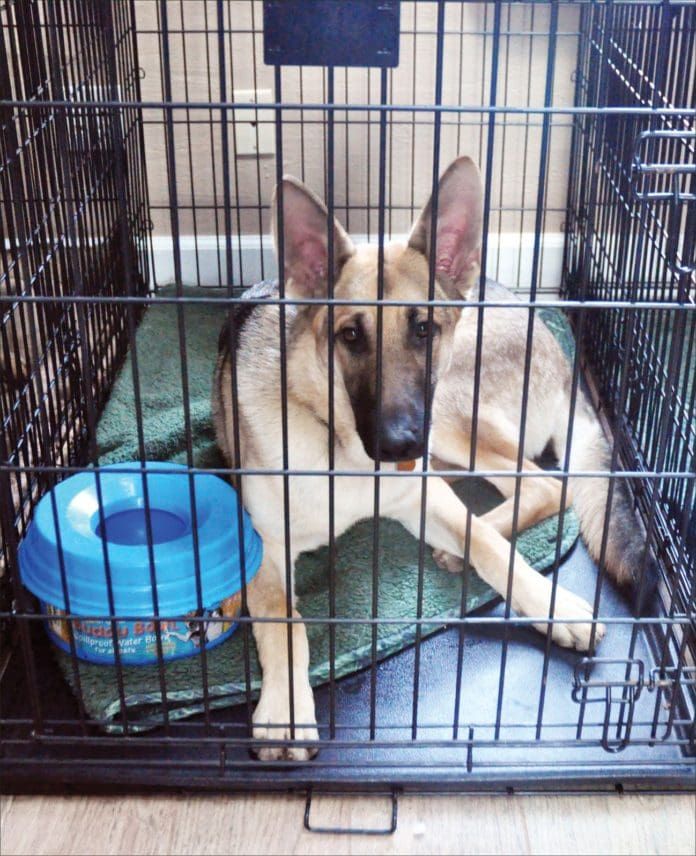Few things are worse than hearing the vet say those dreaded words: “Cage Rest.” Most often the consequence of an injury or major surgery, it means your dog must be kept under tight restrictions – in a crate, out to relieve herself on leash only, and then back in her crate. Running, jumping, and playing are strictly prohibited; even excessive walking is frowned upon. To make matters worse, this period of restricted activity is sometimes prescribed for as long as four to six weeks. Most of our dogs barely get enough exercise as it is . . . How do you keep a young, active dog under wraps for a whole month or more? Boredom is your biggest enemy. Here are some suggestions to help you through the dark days:
1. Give Your Dog Mental Exercise
What a fantastic opportunity to do a whole ton of training! When our young Corgi, Lucy, was laid up for six months (yes, you read that right), we had plenty of time to practice non-active behaviors such as Stay, Nose Touch, Paw Touch, Relax, Find It (low-activity version), Hold It, Rest Your Head, Polite Leash Walking, and many more.
You can also keep your dog’s body and brain well exercised with some of the more sedentary puzzle toys for dogs. Challenging mental exercises can be as tiring as physical exertion! Shaping and imitation training can be particularly good for that brain-drain effect. Careful behavior choices for these options (small, precise behaviors rather than big, active ones) can keep you and your dog playing by the restricted activity rules.
This is also an ideal time to work on the Karen Overall Protocol for Relaxation with your dog. This protocol is laid out as a 15-day program (although you can take longer if you wish or need to), with your dog learning to calmly sit or lie down in one place for increasing periods of time while you do other things.
2. Cuddle Up with Your Dog
Put on your favorite soothing CD, turn the lights down low, and snuggle up with your shut-in. You might also light an aromatherapy lavender candle or employ a diffuser with a calming aromatherapy lavender essential oil. (It’s important to use only therapeutic-quality essential-oil products. To identify them, see “Aromatherapy for Dogs,” and “Therapeutic Essential Oils for Your Dog.”) Your dog will likely appreciate the one-on-one time with you – unless she finds snuggling aversive, in which case, skip this step.
3. Massage Your Dog
Even if your dog’s not a fan of cuddling, she can benefit from some skilled calming massage or TTouch. Get yourself a good book on canine massage, or round up some T-Touch resources, put on your calming music CD, light the lavender candle, and start massaging. Remember that calming massage should be comprised of slow, steady pressure, not fast rubbing and patting. Any talking should also be a low, calm voice, not the high-pitched tones we use to increase canine enthusiasm in training routines.
4. Provide Toys and Bones
Stock up on Kong toys, other similar sturdy stuffables, and raw meaty bones, so you can keep your dog happily engaged when you cannot personally attend to her. Chewing is a great stress-reliever, and can help take some of the angst out of her confinement.
5. Supply Your Dog with Environmental Aids
In addition to the “Through a Dog’s Ear” music, consider using Adaptil spray, which is said to mimic the calming pheromones a mother dog emits when she is nursing her puppies. Nutraceuticals such as Anxitane and Zylkene may also have a calming effect. Calming herbs for dogs such as chamomile can be useful. Commercial herbal calming products include Composure, PetCalm, Quiet Moments, and Dr. Harvey’s Relax. Your vet may also prescribe a short course of sedatives to get your dog through the first couple of weeks, when strict cage rest is likely the most crucial.
Making use of all five of the above suggestions, we survived six months of Lucy on restricted activity with only one bout of OCD tail-chasing. In fact, her healing exceeded the orthopedic veterinarian’s expectations and we were able to cancel her planned second surgery. Here’s wishing you the same success if you and your dog find yourselves in a “cage rest” scenario.
Pat Miller, CBCC-KA, CPDT-KA, is WDJ’s Training Editor. Pat is also the author of many books on positive training.







Sadly the links in this post don’t work.
Crates are cruel
It’s sadly required when dogs have surgery or have other temporary debilitating situations. This is a guide simply for people whom are taking care of dogs that aren’t allowed to move for long periods of time.